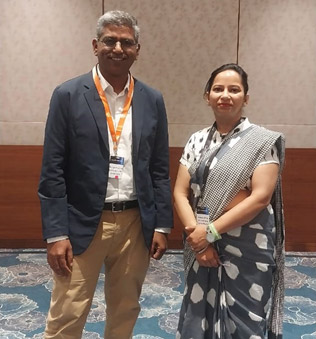
I recently had the pleasure of speaking with Mr. Durga Prasad Kakaraparthi at the “AWS Empower India” event in Delhi. As the Head of AWS Solutions Architecture for the Public Sector, Mr. Kakaraparthi shared profound insights into the transformative impact of cloud computing and generative AI on India’s public sector. His extensive experience in cloud technology and digital transformation provided a comprehensive overview of the current landscape and future potential of these technologies in enhancing public services and governance.
The Current Landscape of Cloud Adoption
Mr. Kakaraparthi began by highlighting the exciting times for cloud adoption within the Indian public sector. He noted that while cloud spending remains relatively low, there is a significant opportunity for growth as organizations increasingly recognize the benefits of agility, security, and innovation that cloud solutions offer. He stated, “It is very early stage of cloud adoption, both in public sector and enterprises,” emphasizing that the COVID-19 pandemic has accelerated this trend as organizations see the value in moving to the cloud.
Since 2017, AWS has trained over 5.9 million individuals in India and 8.3 million across Asia-Pacific and Japan with cloud skills. This initiative is part of AWS’s broader commitment to making AI, machine learning (ML), and generative AI skills training accessible to everyone through various programs, including the new ‘AI Ready’ initiative. AWS aims to provide free AI skills training to 2 million people by 2025 under this commitment.
A 2022 NASSCOM study underscored this potential, predicting that large-scale cloud adoption could contribute approximately $380 billion to India’s economy and create 14 million jobs by 2026. This statistic illustrates the economic significance of embracing cloud technology across various sectors.
National Platforms and Digital Public Infrastructure
Mr. Kakaraparthi elaborated on India’s digital transformation journey through initiatives like Digital Public Infrastructure (DPI). He explained that India is one of the first countries to lead in digital transformation with its DPIs, designed to bridge barriers across its diverse population. These platforms utilize open-source technologies and APIs to facilitate access to services for citizens from different backgrounds.
He cited examples such as DigiLocker and CoWIN, which are national platforms running on AWS. “We are working with government organizations at the highest level to expand that impact to citizen level,” he stated. The focus on creating national platforms highlights a shift towards a more inclusive approach to governance.
National Health Authority (NHA)
A key example of AWS’s impact is its collaboration with the National Health Authority (NHA), which builds on AWS to transform healthcare at population scale and establish an open digital health ecosystem in India. The NHA is responsible for implementing two flagship schemes: Ayushman Bharat–Pradhan Mantri Jan Arogya Yojana (AB-PMJAY) and the Ayushman Bharat Digital Mission (ABDM).
AB-PMJAY aims to provide affordable healthcare services to over 550 million economically vulnerable citizens, offering cashless access to secondary and tertiary health services. The NHA currently processes more than 1.5 million claim documents monthly, having issued over 354 million Ayushman cards and empanelled more than 30,000 hospitals across 25 states and 8 union territories.
Generative AI: Revolutionizing Public Services
AWS is making significant strides in generative AI, training over 5.9 million individuals in India and 8.3 million across Asia-Pacific since 2017. In May 2024, AWS launched Amazon Bedrock in the Asia Pacific (Mumbai) Region, a fully managed service that simplifies the development of advanced generative AI applications using high-performing foundation models from leading AI companies.The National Health Authority (NHA) is leveraging AWS to enhance healthcare delivery for over 550 million citizens through initiatives like the Ayushman Bharat–Pradhan Mantri Jan Arogya Yojana (AB-PMJAY). This program provides cashless access to healthcare and processes over 1.5 million claims monthly, with more than 354 million Ayushman cards issued.
AWS’s generative AI capabilities are structured across three layers. The bottom layer provides purpose-built infrastructure for AI workloads, utilizing tools like AWS Trainium and AWS Inferentia. The middle layer offers tools and pre-trained foundation models for building and scaling generative AI applications, exemplified by Amazon Bedrock. Finally, the top layer consists of user-friendly applications that require no machine learning expertise, such as Amazon Q, enabling organizations to leverage generative AI technologies easily. Together, these layers equip organizations with the necessary resources to harness the power of generative AI effectively.
Additionally, AWS has partnered with Redington to launch Red.AI, aimed at helping technology partners adopt generative AI solutions in sectors like EdTech and healthcare. This initiative will provide training and support for proof-of-concept development.
In Tamil Nadu, AWS is collaborating with the iTNT Hub to establish a Generative AI Startup Hub, offering mentorship and resources to emerging founders from over 570 colleges affiliated with Anna University. This hub will focus on developing citizen-driven generative AI solutions and fostering innovation in Tier 3 and 4 cities.
Lastly, Digii, an AWS Technology Partner, has introduced DigiiAI, a solution designed to streamline administrative tasks for faculty across more than 20 educational institutions in India, enhancing efficiency and personalizing support for educators.
The Future Vision: Viksit Bharat 2047
Looking ahead, Mr. Kakaraparthi spoke about India’s ambitious vision for becoming a developed nation by 2047 (Viksit Bharat 2047). He believes that leveraging cloud computing and generative AI will be crucial in achieving this goal. By fostering innovation through technology, India can enhance its governance structures significantly.
He concluded with a powerful statement: “Cloud and generative AI together can fast-track India’s mission towards becoming a developed nation.” This encapsulates his belief that embracing these technologies will drive economic growth while improving quality of life for millions across India.









